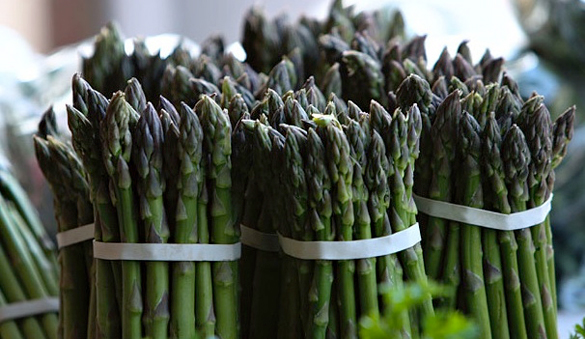In Season for April: Asparagus Signals That Spring Is Here!
At long last, it’s spring! Linda LaRue makes tasty asparagus her in season pick for April!

You know it’s spring when you begin to see asparagus at the vegetable aisle of your supermarket or at your local farmer’s market. It’s always a welcome sight to me after a long cold dreary winter. I think that’s why I am always happy when I think of asparagus—because it signals the end of winter and beginning of spring.
Water makes up 93 percent of asparagus’ composition. Asparagus is low in calories and is very low in sodium. It is a good source of vitamin B6, vitamin A, vitamin C, vitamin E, vitamin K, thiamin, riboflavin, niacin, folic acid, calcium, magnesium, zinc, iron, phosphorus, potassium, copper, manganese and selenium, as well as chromium (a trace mineral that enhances the ability of insulin to transport glucose from the bloodstream into cells).
Cool Asparagus Nutrition Facts
The good news: Studies reveal interesting new data about asparagus that indicates it has some probiotic benefits. So it may ease gas build-up, helping belly bloat. Asparagus is one of the best natural diuretics, which will help flush waste and excess water from your body.
The bad news: During digestion, the vegetable’s sulfurous amino acids, primarily mercaptan, break down into smelly chemical components. Because those components are “volatile,” meaning airborne, the odor wafts upward as urine leaves your body and can be detected as soon as 15 minutes after ingestion.
The takeaway: If that old expression is true that, “70 percent of six-pack abs are made in the kitchen,” you may want to add asparagus this spring as one of your go-to veggies.
Types of Asparagus
Asparagus comes from the Lily family (liliceae) along with the onion, garlic and tulip. According the Encyclopedia Brittanica, there are around 300 species of the asparagus family around the world.
Green Asparagus
. Green asparagus gets its color from the process of photosynthesis as its spears peep up from the soil into direct sunlight come spring.
White Asparagus.
White asparagus has long been considered a delicacy, particularly by Europeans, and commands about double the price of green asparagus. The main reason that white asparagus is more expensive is that there is a limited supply, and the production costs are high. White asparagus is exactly the same variety as green asparagus, with the only difference being that white asparagus is grown in the dark. When asparagus spears are exposed to sunlight, they first turn pink and then later, the familiar green color due to photosynthesis.
Purple Asparagus. The purple color comes from the high levels of anthocyanins (potent antioxidants) in its spears, which also gives it a more fruity flavor. It has a lower fiber content than white or green asparagus, thus making it more tender. Purple asparagus produces sweeter, thicker spears than green or white asparagus.
How to Buy, Store and Use Asparagus
How to buy: Choose firm, bright green asparagus stalks with plump, tightly closed tips. Check the ends of the stems to make sure they look freshly cut—not shriveled or dried out. Avoid fading color, because it is a tell tale of significant deterioration.
Thin spears or thick spears? Both can be sweet and tender—so long as they’re fresh! The diameter of an asparagus spear indicates when it was harvested. Thick spears are generally harvested in the early spring, and thinner stalks appear as the growing season wears on into summer.
How to store
: Uncooked asparagus will stay fresh for up to one week in the refrigerator. Store spears upright in a container with the stems wading in an inch of water, then cover loosely with a plastic bag. (My secret to keeping them freshest is to cut of about an inch off the stems before storing them upright in a container with about an inch of water.) I recommend that you change the water daily.
How to prepare, peel and trim: Use a vegetable peeler to take off the outer layer. This will eliminate most of the stringiness and remove any sand hiding in the fronds on the stalk. Peeled asparagus cooks quickly; the stems and tips will be done at the same time. To keep the asparagus a vibrant green, plunge them in a water-ice bath for a couple minutes immediately after cooking.
Conventional asparagus wisdom says snapping the spear breaks away the tough, fibrous end. This works well when harvesting in the field, but in the kitchen it’s a sad waste of good food. Once a spear has been peeled, simply cut off the dry white stems. Correct cooking results in vibrant green spears with a tender crisp texture.
Stay tuned tomorrow when I share one—well, actually two—of my favorite ways to eat asparagus! In the meantime, tell me, what’s your favorite variety of asparagus? —Linda
